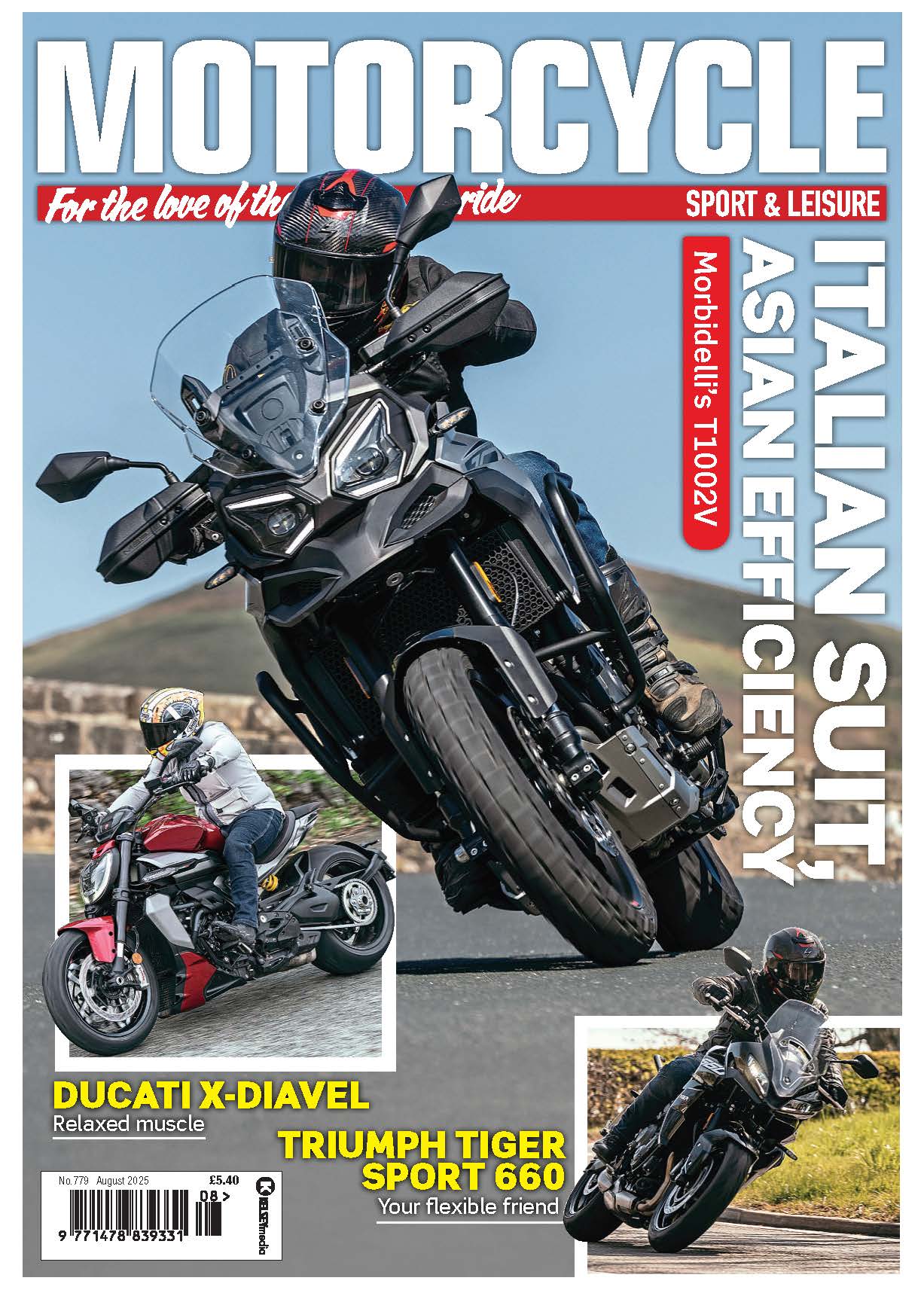Dave tests out a Ducati DesertX on a mini adventure, exploring the lesser-known roads of France.
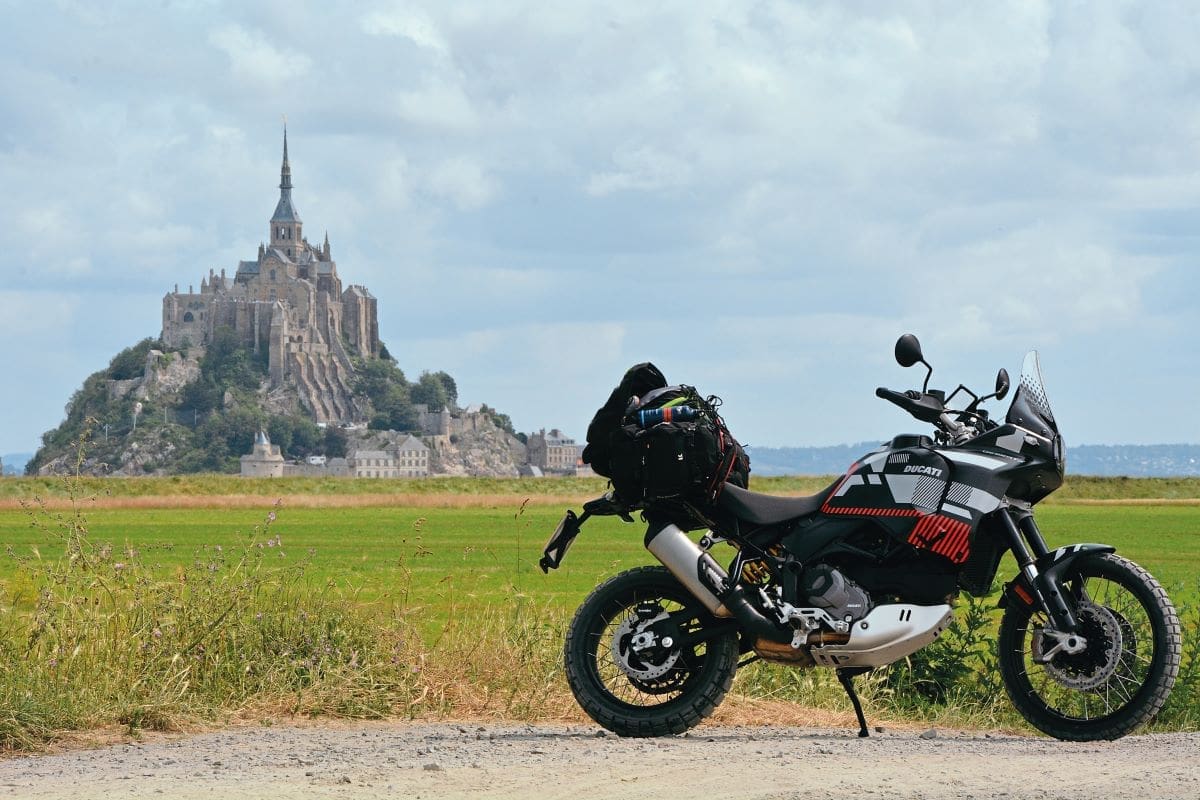
Words & photography : Dave Manning
Given that the current glut of large-capacity off-road style motorcycles are classed as adventure bikes, it makes sense to go out and try and find an adventure, right?
In our busy modern lives, few of us can take several weeks, months or even longer off work to jump on a bike and go exploring – whether that be in our own country or continent, or even on a global expedition. Let alone actually be able to finance such a life-affirming experience.
But, of course, you don’t have to jack in your daily job and abandon all friends and family to selfishly ride around the planet to have an adventure. That can be accomplished in just a few days, or even an afternoon if you’re feeling especially focused. Although, from my perspective, if you want to feel justified in terming a ride out on your bike as being ‘an adventure’ then there has to be a certain element of uncertainty, and it always helps if you start out by travelling over water, to give a sense of travelling to foreign parts (even if that does just mean going over the Humber Bridge).
So, with a Ducati DesertX sat in the starting blocks, I booked a ferry from Portsmouth to Caen, with no hotels booked, no routes saved in any kind of satnav, and no real plan of which direction to head. Just a map book, a tent and a yearning to see new places, and get some warm sun on my aging bones.
Now, this happy-go-lucky approach did mean that I neglected a couple of things that might have been rather important and that I only discovered after my return home. Firstly, that road users in France must carry two alcohol test kits, and motorcyclists must wear CE-approved gloves. The gloves weren’t an issue, although apparently there’s also a requirement in France for a ‘Crit-Air certificate’ to be able to enter certain towns and cities – the certificate only costs a fiver and is dead easy to apply for online, but I didn’t know about it beforehand, and wasn’t planning on visiting any big places anyway (although this did actually change, all part of the planned flexibility).
I’d strapped on my Kriega luggage which, refreshingly, was really easy to do on the Ducati thanks to the flat pillion seat and the tubular subframe that isn’t hidden behind smooth bodywork, and with a cargo net over the top, plus a couple of extra bungees, I’d got a rucksack with my camera gear and my little two-man tent all held securely in place. So, without a thought of working out how to change rider modes, phone connectivity or any of the tech that just about every new bike is spec’d with, I slung a leg over and headed south.
The schlep down to Portsmouth wasn’t as dull as I’d expected, being mostly dual carriageway at each end (A1 and A3) with some motorway in the middle (M1 and M25), with the speed cameras safely neutered thanks to the cruise control, albeit with some confusion as to how much or little the speed changed with a single press of the button. It took at least half of my trip away before I realised that one press equated to 1kph, so a change of speed limit from 60 to 70mph meant 16 presses of the button…
Having carved my way through standing traffic around Heathrow – the tall riding position and narrow width making this oh-so-easy – I found myself swooping along the A3 through the South Downs well ahead of time. A sarnie and brew stop at a services convinced me I had time for an explore, and I found a little trail through pine trees to a beautiful piece of heathland. Perfect for some pics and a piece to camera (yes, there’s a video, see the link) and a chill-out listening to bird song and chirruping grasshoppers. Followed by a brief attempt at working out how the rider modes are changed, at which I failed, even with the help of a passer-by on an electric off-road skateboard (yes, there is such a thing!).
My ferry was an overnighter, planned as such so that I could use days for riding and covering interesting miles, rather than be sat, wide awake and twiddling my thumbs for six hours while crossing the Channel. Consequently, I rolled on to French soil at around 6am, into the cool, grey dawn of Caen with a handy lack of traffic to spoil my trip westwards visiting the Normandy landing beaches of Sword, Juno, Gold, Omaha and Utah. I was too early for any of the museums along the wonderfully twisting and picturesque route between the beaches, so with the five ticked off I headed further west, aiming for Mont Saint Michel and another photo opportunity, followed by a southerly blast on autoroute, looking for warmth.
There followed five days of riding away from any kind of autoroute or peage, using the ‘non-motorway’ option on Google maps to plot a rough course to the kind of area I thought about heading to. Past La Rochelle; on the ferry from Royan to Port Medoc; southwards past Montalivet and through glorious pine forests alongside pristine sandy beaches (nigh devoid of people); a ride through Bordeaux to remind myself of what traffic was; and down to Cap Breton.
The weather took a turn for the worse and I headed away from the coast, through Bergerac and towards Limoges, paying a visit to Oradour (see boxout), then northwards, the rain on my tail, before being caught in the heaviest of monsoon-like downpours just 10 miles from the ferry terminal.
Throughout all of that, the DesertX was my faithful companion – taking autoroute; twisting forestry lanes; fire roads; sandy beach access roads; fraught city traffic in Bordeaux; die-straight single lane roads through mile upon mile of sweetcorn fields; and some of the quietest roads I have ever ridden on. And, while a lot of bike tests are undertaken over a short period of maybe a day or two, the long (very long) weekend that I’d planned allowed me and the Ducati to become rather well acquainted.
Watch the video:
The bike itself
The styling is what Ducati refer to as being ‘Post Heritage’… no, I’ve not got a clue either, although I’m guessing it’s their term for referencing past machinery such as the Cagiva Elefant built in the late Eighties, powered by a Ducati engine and with distinct Paris-Dakar race bike styling. Styling that the DesertX replicates very accurately. It’s a retro style that’s become popular of late, with echoes of it on Yamaha’s 700 Ténéré, and even the latest iteration of the Suzuki V-Strom, too.
The styling on the Ducati brings the neat and effective screen, which isn’t as noisy as some, and neatly shrouds the tall TFT dash while still leaving room for a phone mount. The mirrors are perhaps the best I’ve ever experienced on a bike, and the twin headlights are reasonable, too. There were some very slight vibes through the pegs at about 80mph, but that only resulted in numb toes once, after a prolonged peage run.
The 937cc version of the Testastretta engine is sublime, punchy from low revs, smooth, too, and seemingly happy at all points through the rev range. And that airbox roar – oh, yes!
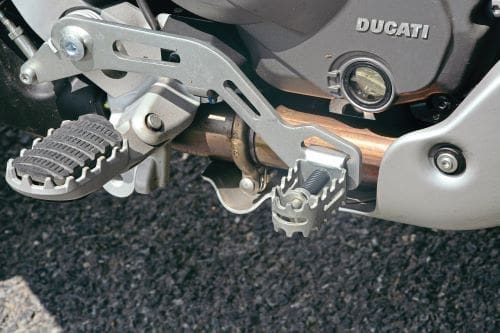
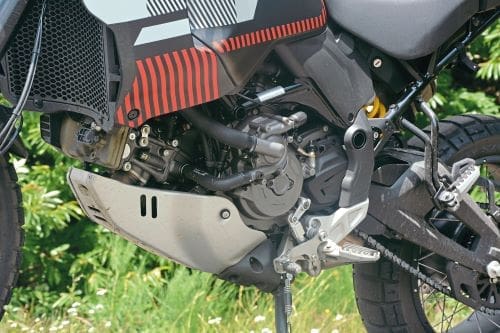
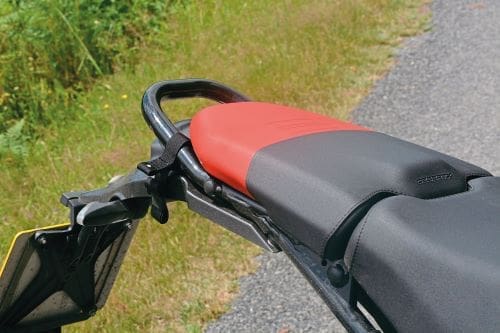
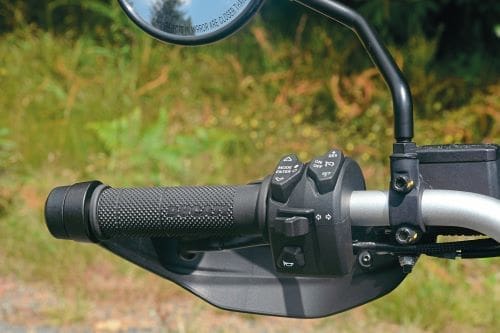
The bars are the perfect height for standing, aided by the very neat adjustable brake pedal tip, and the power can be tailored to suit off-road, with the rider modes allowing a reduction from the usual 110bhp to a dirt-friendly 75bhp or 95bhp if you’re feeling feisty… I had just one issue with that. How the hell do you change modes? I was stuck in Sport, which was no bad thing to be fair – the only time it was inappropriate was on fire break trails (and that wasn’t really an issue, given the sublime low rpm throttle control) and when I took it on to what, given the name, you may assume was its natural terrain… sand. In that instance, the traction control cut power to the point where it stalled and stalled again. But that, of course, wouldn’t have been an option if the idiot in control had sussed out the rider modes. The Pirelli Scorpion Rally STR are ace tyres, confidence-inspiring even in torrential rain, and giving feedback at decent levels of lean (not always the case with knobbly rubber), and they’re quiet, too. But not great in sand…
And, on Tarmac, it handles as well, if not better, than any other adventure bike on the market, despite having a dirt-friendly 21-inch front wheel and a long wheel base (astoundingly, 94mm longer than a 1250GS!).
We averaged 57.2mpg over the entire trip. Slightly higher for initial bumbling, and slightly lower (but still over 57mph) when enjoying that airbox roar to the full… essentially, that means a capability of 200 miles before needing fuel, which just so happens to be about the distance that one’s posterior remains comfortable. Although if you’re of iron butt class, there’s a factory accessory extra fuel tank that attaches to the rear right-hand side, adding eight litres, or nigh on another 100 miles.
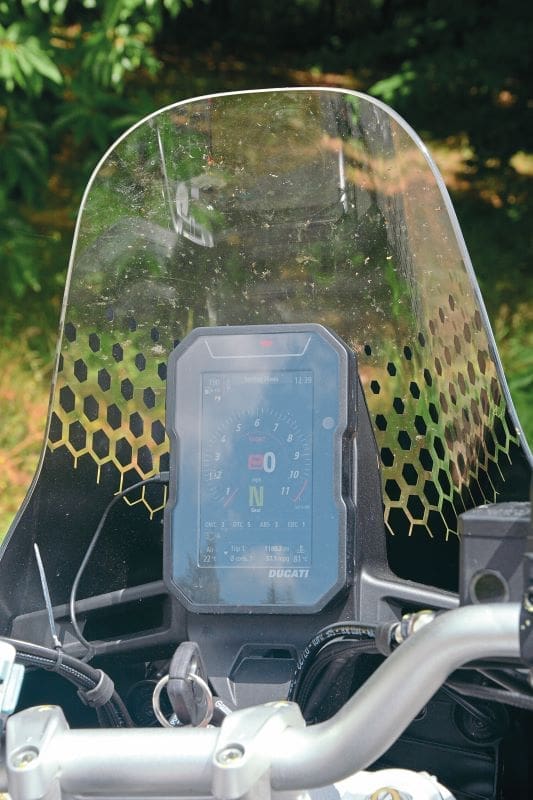

Heading back towards Caen, I noticed that the chain was slightly slack, so I whipped the seat off to access the tool kit. Hmm, under the seat is a pair of Allen keys and an L-shaped screwdriver gizmo. So, the full toolkit must be under the passenger seat, accessed by using the smaller Allen key? Nope, nothing under there. A quick look at the owner’s manual suggested that chain tension could be sorted by a ‘visit to a Ducati dealer or authorised service centre’… Hmm, one wonders what sort of person would consider that an adventure bike shouldn’t be equipped with a tool kit – aside from one who is supremely convinced of a lack of mechanical issues, servicing or accidents perhaps?… Although, with servicing in mind, the valve clearance check only needs to be done every 18,000 miles!
While the owner’s manual also suggests that many other (usually menial) checks should be done by taking the bike to your dealer, the suggestion that maintenance cannot be done by the owner and only by an official Ducati workshop was the only fault I could level at the DesertX. The inability to change rider modes was entirely my problem, and throughout all of the varied terrain that I took the bike on, I felt that it couldn’t have been bettered by anything. At all. I admit, that is quite a statement, and there could be other bikes on which I’d have a similar feeling on my return, but the DesertX really got under my skin, leaving just one question. What is the new DesertX Rally like?…
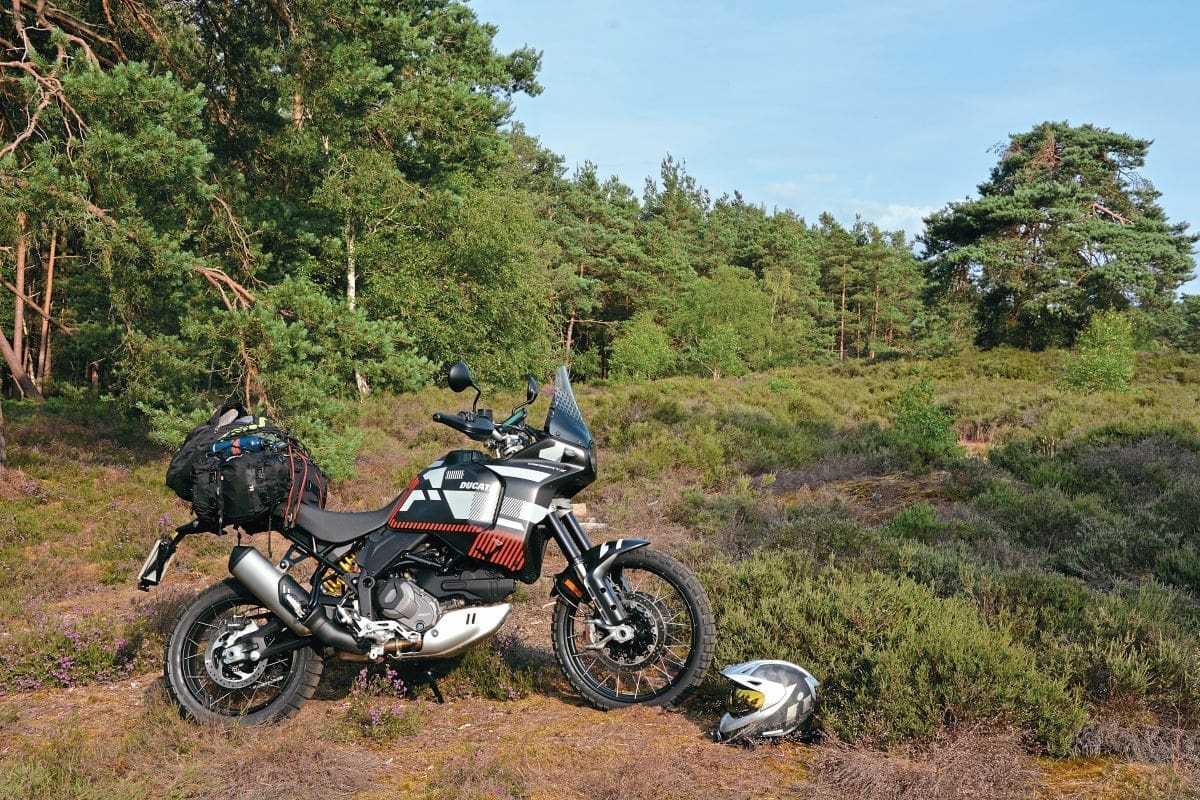
Specification
Ducati DesertX
Price: £14,995
Engine: 937cc, vee twin, 4 valves per cylinder, water-cooled
Power: 110bhp (81kW) @ 9250rpm
Torque: 68lb-ft (92Nm) @ 6500rpm
Frame: Tubular steel trellis
Wheelbase: 1608mm
Brakes: (F) Twin 320mm semi-floating discs, Brembo radial mount 4 piston calipers, (R) 265mm disc, floating Brembo 2 piston caliper, Bosch cornering ABS
Transmission: 6 gears, chain final drive, DQS (Ducati Quick Shift, up & down)
Suspension: (F) 46mm KYB upside down forks, fully adjustable, 230mm travel (R) KYB Monoshock, fully adjustable, remote preload adjuster 220mm travel
Wheels/Tyres: (F) 2.15” x 21” cross-spoked tubeless, Pirelli Scorpion Rally STR 90/90×21 (R) 4.15”x 18” cross-spoked tubeless, Pirelli Scorpion Rally STR150/70×18
Seat height: 875mm (34.4”) (890mm and 865mm options)
Fuel capacity: 21 litres
MPG: 57mpg (tested) 50.4mpg (claimed)
Weight: 223kg
Warranty: 48 months unlimited mileage
Service intervals: 9000 miles / 24 months
Contact: www.ducati.com

